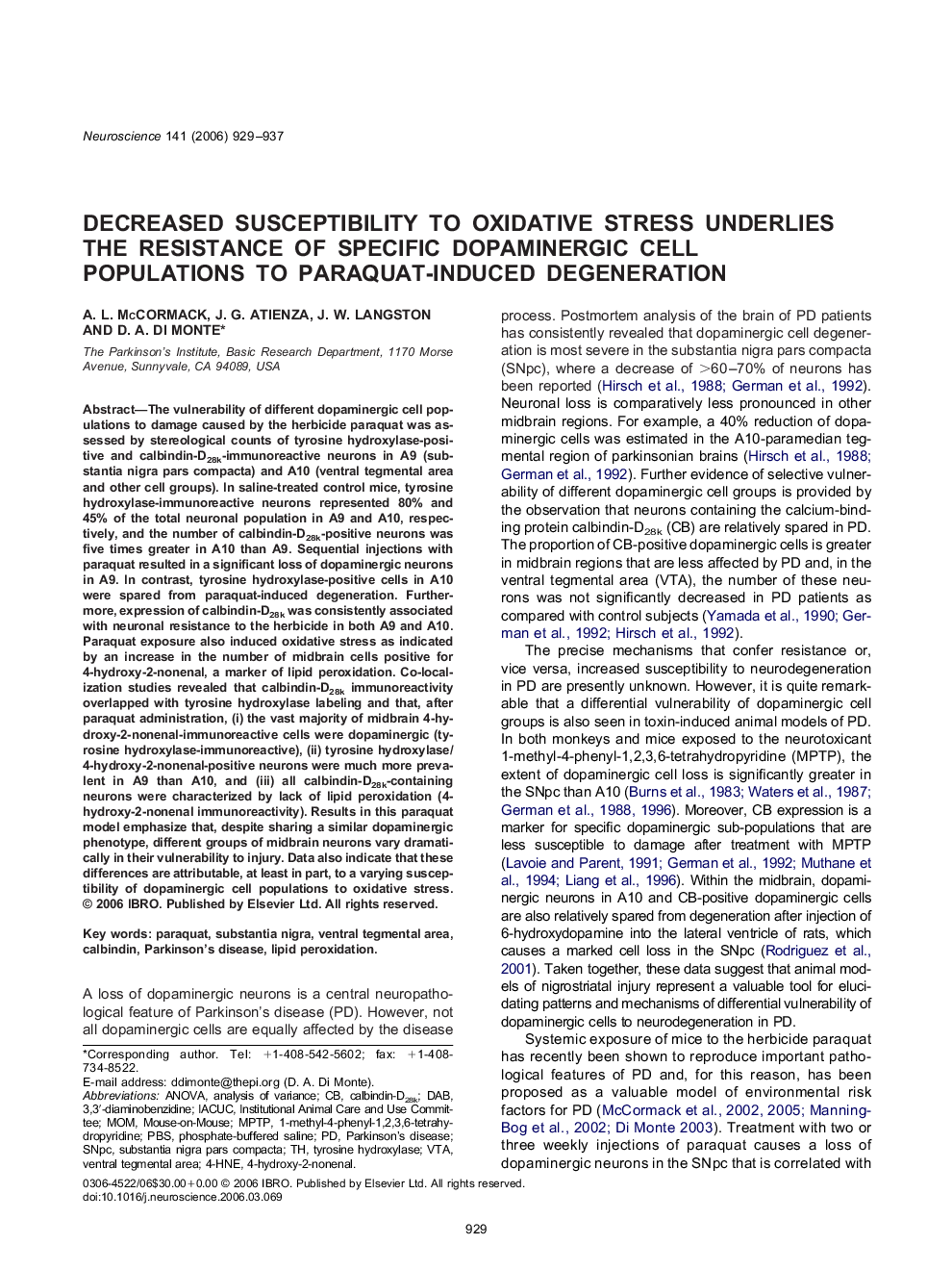| کد مقاله | کد نشریه | سال انتشار | مقاله انگلیسی | نسخه تمام متن |
|---|---|---|---|---|
| 4342783 | 1295892 | 2006 | 9 صفحه PDF | دانلود رایگان |
عنوان انگلیسی مقاله ISI
Decreased susceptibility to oxidative stress underlies the resistance of specific dopaminergic cell populations to paraquat-induced degeneration
دانلود مقاله + سفارش ترجمه
دانلود مقاله ISI انگلیسی
رایگان برای ایرانیان
کلمات کلیدی
Calbindin-D28kDABPBSIACUCVTA4-HNEMPTP1-methyl-4-phenyl-1,2,3,6-tetrahydropyridine - 1-methyl-4-phenyl-1،2،3،6-tetrahydropyridine3,3′-diaminobenzidine - 3،3'-diaminobenzidine4-hydroxy-2-nonenal - 4-هیدروکسی-2 غیرنالSNpc - SNPCParkinson’s disease - بیماری پارکینسونanalysis of variance - تحلیل واریانسANOVA - تحلیل واریانس Analysis of variancesubstantia nigra - توده سیاهsubstantia nigra pars compacta - توده سیاه پارس متراکمtyrosine hydroxylase - تیروزین هیدروکسیلازInstitutional Animal Care and Use Committee - سازمان مراقبت و مراقبت از حیواناتMoM - مامانPhosphate-buffered saline - محلول نمک فسفات با خاصیت بافریventral tegmental area - ناحیه تگمنتوم شکمیParaquat - پاراکواتLipid peroxidation - پراکسیداسیون لیپیدcalbindin - کلبیندین
موضوعات مرتبط
علوم زیستی و بیوفناوری
علم عصب شناسی
علوم اعصاب (عمومی)
پیش نمایش صفحه اول مقاله

چکیده انگلیسی
The vulnerability of different dopaminergic cell populations to damage caused by the herbicide paraquat was assessed by stereological counts of tyrosine hydroxylase-positive and calbindin-D28k-immunoreactive neurons in A9 (substantia nigra pars compacta) and A10 (ventral tegmental area and other cell groups). In saline-treated control mice, tyrosine hydroxylase-immunoreactive neurons represented 80% and 45% of the total neuronal population in A9 and A10, respectively, and the number of calbindin-D28k-positive neurons was five times greater in A10 than A9. Sequential injections with paraquat resulted in a significant loss of dopaminergic neurons in A9. In contrast, tyrosine hydroxylase-positive cells in A10 were spared from paraquat-induced degeneration. Furthermore, expression of calbindin-D28k was consistently associated with neuronal resistance to the herbicide in both A9 and A10. Paraquat exposure also induced oxidative stress as indicated by an increase in the number of midbrain cells positive for 4-hydroxy-2-nonenal, a marker of lipid peroxidation. Co-localization studies revealed that calbindin-D28k immunoreactivity overlapped with tyrosine hydroxylase labeling and that, after paraquat administration, (i) the vast majority of midbrain 4-hydroxy-2-nonenal-immunoreactive cells were dopaminergic (tyrosine hydroxylase-immunoreactive), (ii) tyrosine hydroxylase/4-hydroxy-2-nonenal-positive neurons were much more prevalent in A9 than A10, and (iii) all calbindin-D28k-containing neurons were characterized by lack of lipid peroxidation (4-hydroxy-2-nonenal immunoreactivity). Results in this paraquat model emphasize that, despite sharing a similar dopaminergic phenotype, different groups of midbrain neurons vary dramatically in their vulnerability to injury. Data also indicate that these differences are attributable, at least in part, to a varying susceptibility of dopaminergic cell populations to oxidative stress.
ناشر
Database: Elsevier - ScienceDirect (ساینس دایرکت)
Journal: Neuroscience - Volume 141, Issue 2, 2006, Pages 929-937
Journal: Neuroscience - Volume 141, Issue 2, 2006, Pages 929-937
نویسندگان
A.L. McCormack, J.G. Atienza, J.W. Langston, D.A. Di Monte,